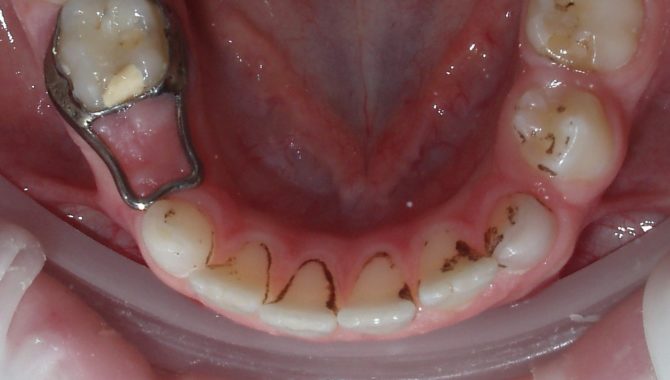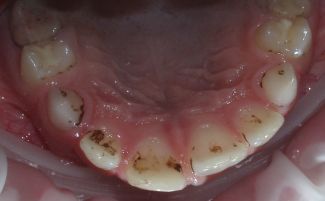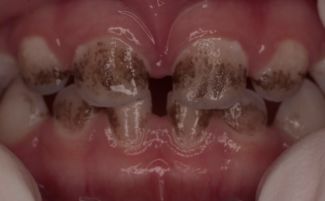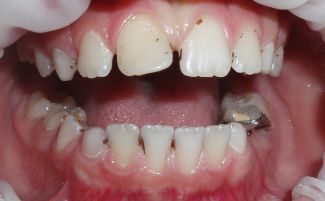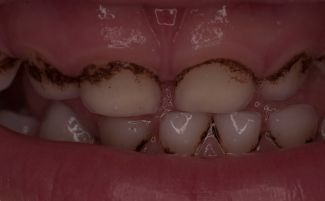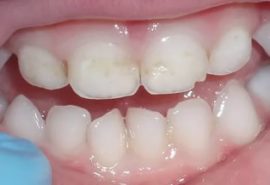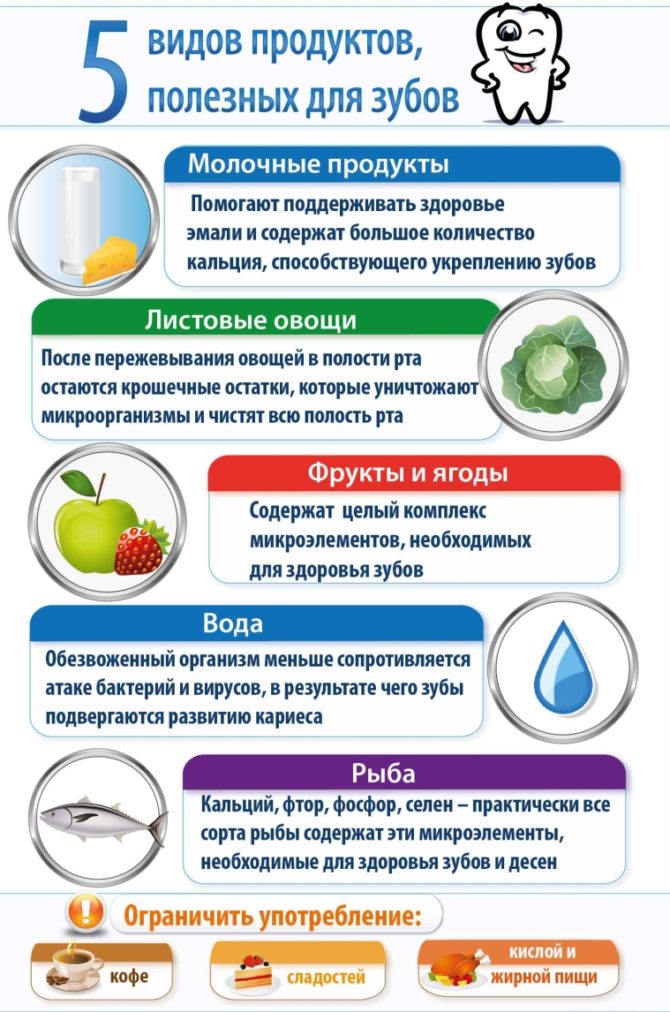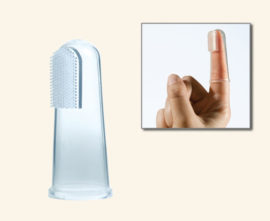Plaque Priestley on baby teeth in a child: causes, treatment, prevention
Priestley plaque in children is a fairly common occurrence. It not related to age and can be formed both in 2-3 years, and in a year. Besides the fact that it brings aesthetic discomfort, dark plaque is also the cause of an unpleasant odor from the oral cavity. There are many reasons for the appearance of black teeth, and only knowing what caused it in each case, you can get rid of an unpleasant disease.
Content
What is Priestley's raid
Plaque on tooth enamel is nothing more than an uneven border of dark color, distributed along all teeth. In rare cases, it appears as a small speck or dot. Plaque is mainly formed on the inside of children's teeth, but there are cases of external formation.
In this case, it is impossible to get rid of the black color of the teeth by simply thoroughly brushing them with a paste. The fact is that the formation of plaque is associated with the presence of certain types of bacteria in the child's oral cavity. As a result of their life on the enamel deposits occur, which cause pigmentation.
Not every child has a black plaque on his teeth. This is due to the fact that the body reacts differently to changes in food, the environment. Someone may develop a dot to a spot gradually, and in some children they form abruptly, literally in one night. And it doesn’t matter how old the child is: black plaque in children, as in the photo, can also appear when the first teething occurs. But on average, it forms in 2 years.
The danger does not lie with the education itself, but with the reason why it appears. After all, this is a signal not only about problems of a dental nature, but other diseases of the body. In this case, you must urgently consult a doctor.
A photo of Priestley's raid in children can be seen below:
Causes of black plaque on teeth in children
Many parents have a question, why exactly children 2-4 years old are affected by this disease? There are several reasons for this:
- Dysbacteriosis can cause the multiplication of bacteria. He, in turn, is a consequence of disturbances in the digestive system due to its lack of formation. It can also be due to malnutrition of the baby or taking antibiotics, diseases of the liver or intestines, which are in a chronic form.
- The cause of the appearance of black spots on the teeth is considered to be caries, and, as a result, a black coating on the baby’s teeth is formed.
- Most often in a year and even two parents do not care about the baby’s teeth, do not brush them. This can cause yellow plaque to become darker over time.
- Irregular brushing of teeth at any age of the child leads to the same result. The remains of food and dead mucosa settle on the teeth, leading to darkening of the enamel.
- Another reason why a child has a black plaque on his teeth is congenital hypoplasia of tooth enamel. The disease is associated with the underdevelopment of the upper layer. As a result, it is weakened, does not fully fulfill the protective function, therefore, a black plaque appears on the child’s teeth.
- Black teeth in children can be the result of adverse effects at the stage of development of the tooth germ. This may be an insufficient amount of calcium or an excess of iron in the diet of a pregnant woman.
Severe viral infections transferred during pregnancy lead to the same consequences.
- When using drugs and supplements containing iron, it may form excess substances in the body of the child, which also becomes the cause of plaque. In this case, it is not black, but dark brown or purple.
- A lack of calcium in children under one year of age leads to changes in the color of enamel;
- A child’s black teeth may be due to a weak immune system. One of these reasons may be too dry indoor air. In this case, the production of saliva occurs in insufficient quantities. Weakens the body and diseases of a protracted nature, when a child has to use many medications that adversely affect the functioning of the gastrointestinal tract.
- A black plaque on the teeth may form due to an incorrect bite or dental disease, in which you have to chew on one side. In this case, the idle side will be covered with a coating.
- Enamel darkens and excessive consumption of sweets;
- With diseases of the thyroid gland and with diabetes, teeth often turn black;
- In rare cases, the cause for the appearance of formations is heredity. If one of the parents had such problems in childhood, there is a chance that the child will have the disease.
- Plaque can be the result of infection with worms and other parasites.
In these deposits there is a large number of different bacteria, not only useful, but also aggressive. If you do not observe oral hygiene and do not remove plaque on time, it will become more dense and will adhere sufficiently to enamel. For bacteria, these are favorable conditions. And multiplying, they lead to darkening of the upper layer of teeth.
The appearance of plaque can spread to both a milk tooth and a permanent one.
It is important for the baby to choose a paste with the correct composition. It should contain minimum amount of fluorine or with its complete absence. An excess of the element leads to the formation of black plaque on the teeth in children. For the most part, this applies to incisors.
Dr. Komarovsky on his official website answers in detail questions from parents about the appearance of black plaque in children. Video of Dr. Komarovsky about tooth diseases in children:
Diagnosis
The formation of black on the teeth can be the result of various diseases. In order not to lose time and not lead to complications, you should consult a doctor who will diagnose and prescribe treatment.
If a stain appears on the tooth, laser diagnostics must be performed. It allows you to determine the stage and depth of caries. Based on the results of the examination, individual treatment is developed.
If other reasons lead to plaque formation, the doctor prescribes additional tests. They will make it possible to make the correct diagnosis and adjust treatment.
How to treat plaque
Regardless of the cause of black plaque formation in children, rough mechanical cleaning is not recommended. This will not only damage the enamel, but also bring only a temporary effect - after a while the black formations will return again. An exception is plaque caused by caries. In this case, you need to contact the dentist and begin to treat the tooth immediately, removing the formation.
.In most cases, the black spot persists until the deciduous teeth are replaced by permanent ones, which are less prone to plaque.
This does not pose any danger to health, so you should only brush your teeth and take care of your oral cavity.
In other cases, the treatment process depends on the cause of plaque formation:
- If black dots appear due to problems with the intestinal microflora, it is necessary to review the nutrition system.The administration of special drugs that establish the balance of microflora is also prescribed.
- With the wrong balance of calcium and iron in the body, an appropriate diet is prescribed. If necessary, treatment with medications is prescribed.
- If tooth decay began at an early age, a silvering or fluoridation procedure can be performed. The process consists in processing tooth enamel with special tools that seem to preserve the development of the coating pathology. This procedure allows you to wait for a change of teeth from milk to permanent without serious consequences.
A little about enamel color enhancing products
You can’t get rid of Priestley's plaque on your own, but you can improve the color of enamel using the following products:
- Eating nuts and seeds can remove plaque and dark spots from the teeth. In addition, it is a source of a large number of vitamins that help strengthen the body and, of course, enhance its protective functions.
- Apples and pears contain a lot of water, which leads to the destruction of dangerous bacteria. They also help strengthen the gums.
- The natural tooth whitener is strawberries. It contains malic acid, which improves the color of enamel.
- Broccoli will help maintain the white color of the teeth. The vegetable also removes dark deposits.
- Water without dyes is the best way to maintain a snow-white smile.
Disease complications
In addition to an aesthetically ugly appearance, black formations can lead to other unpleasant complications:
- the appearance of an unpleasant odor from the oral cavity;
- plaque formation;
- decay of tooth enamel due to carious processes;
- the formation of periodontitis due to lesions of the gingival mucosa in connection with ongoing inflammatory processes;
- the appearance of a sensitive reaction of teeth to temperature changes and taste sensations;
- bleeding gums;
- the development of gingivitis and periodontitis;
- the appearance of inflammatory processes in the gums.
Preventative measures
As you know, preventing the disease is easier than curing it. Therefore, it is necessary to take care of the teeth in advance and follow the important recommendations for prevention:
- As soon as the first tooth has appeared, parents should clean it with a special brush. It is put on the finger, after which the teeth are brushed and simultaneously massage the surface of the gums.
- Already in a year, and if necessary earlier, care for the oral cavity should begin. Until the child learns to brush his teeth correctly, he should be assisted. The child must be able to use the brush correctly and know how to brush his teeth. Carry out a cleaning procedure twice a day - morning and evening. The rest of the time after eating, you must thoroughly rinse your mouth with water or a special tool.
Do not use paste for adults when caring for a child's oral cavity.
- After evening brushing, it is not recommended to eat food, especially sweet.
- A one-year-old child should visit the dentist regularly for prevention. This will help to identify the problem in time.
- During feeding, adults should not lick the spoon with which they feed the baby. Thus, they can transmit bacteria that cause the baby to darken the enamel.
- It is necessary to monitor the children's diet.
Food should be balanced and contain a sufficient amount of vitamins and minerals. Their intake should not lead to a shortage or overabundance of minerals.
- You should not allow your child to drink coffee (you can make a weak drink with milk) and strong tea (it is better to use green or fruit).
- At the same time, the drinking regimen should be correct. The child should consume enough water, especially in hot weather, to avoid dry mouth.
- Observe the correct balance of humidity and temperature in the room where the child spends most of the time.
- The baby’s diet is necessary introduce solid foods in a timely manner. This leads to proper natural cleansing of the surface of the teeth. You can eat vegetables, fruits, crackers, drying and hard cookies.
- To avoid drying of the mucous membrane of the oral cavity, it is necessary to ensure that the child breathes with the help of the nose.
- To form the correct bite should up to a year to wean a baby from a bottle and a dummy.
Only by caring and attentive attitude of parents to the health of the child’s teeth, it is possible to avoid the formation of black plaque and maintain a snow-white smile.

